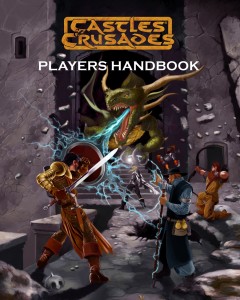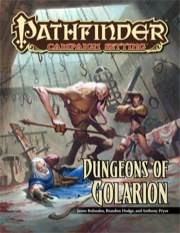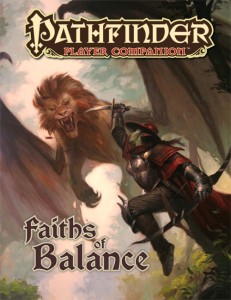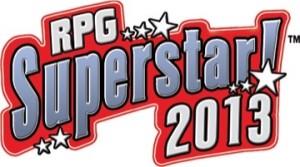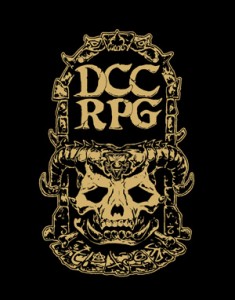 Just before the holidays, Dak (of Crawl! Fanzine fame) posted in the DCC RPG Google+ community about expanding some of the demi-humans race as class options. The one that intrigued me was allowing the Dwarf as written to be the dwarven fighter or warrior and adding a dwarven priest or cleric.
Just before the holidays, Dak (of Crawl! Fanzine fame) posted in the DCC RPG Google+ community about expanding some of the demi-humans race as class options. The one that intrigued me was allowing the Dwarf as written to be the dwarven fighter or warrior and adding a dwarven priest or cleric.
I found myself with a bit of time over the holidays and took a stab at the dwarven cleric class option for Dungeon Crawl Classics RPG. I tried to blend the dwarf class with the cleric class without ending up with something too powerful. I think I am close on the right blend while maintaining some dwarven flavor.
If it needs toned down a bit more I would look at the number of spells again. I’ve reduced them some, but I think I might have room to reduce those some more. Of course, I cut down a lot of the base dwarven class, really keeping a much slower progression rate for Mighty Deed of Arms than a standard dwarf as an ode to being a dwarf.
I have not been able to run this through an actual playtest yet. I am hoping to talk the judge for my new DCC RPG local game to letting me try it out. In either case, give this class a read through and let me know what you think. Feedback is welcomed!
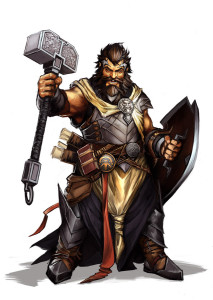
CC License, Arty by *YamaO at Deviant Art
Dwarven Cleric Class
Like their fellow dwarves, dwarven clerics were raised far underground in dwarven mines, strongholds, and great cities. Subscribing to the orderly and rigid life that keeps dwarven society functioning, the dwarven cleric took an interest in the gods of the land. In addition to years of martial training and learning crafts, the dwarven cleric was instructed in centuries religious knowledge and ritual.
The dwarven cleric is a valued member of dwarven society. Life beneath the surface is treacherous. Mining accidents, natural cavern collapses, and near constant skirmishes with other denizens of the dark guarantee physical injury that drive demand for the healing care of a priest. Simply boosting the mental fortitude amongst dark and confined caverns is one of the facets of a dwarven cleric that add to their worth to the dwarven society.
With their martial training, spells, and luck of the gods to aid them during battle, dwarven clerics are an anchor to the foothold these demi-humans claim under the mountains. These features also serve to make them stout adventuring companions.
Hit Die: A dwarven cleric gains 1d8 hit points at each level
Weapon Training: Much like their brethren, dwarven clerics prefer battle with a weapon and shield. With time spent training split between martial and religious training a dwarven cleric is only trained in the following melee weapons: battleaxe, club, handaxe, mace, spear, and warhammer. A dwarven cleric is also trained in these missile fire weapons: crossbow and sling. Dwarven clerics wear whatever armor they can afford.
Alignment: The dwarven life produces many more lawful dwarves due to the structured clan life of dwarves. Coupled with learning the tenets of the religious way dwarven clerics are slanted even more heavily to a lawful alignment.
Rare are the dwarves who stray from the lawful path after studying the ways of religion, but chaotic dwarven clerics do exist. These dwarven clerics have typically rebelled strongly against their roots or some say been tainted by the patrons and deities they serve.
Neutral dwarven clerics are even rarer and tend to be dwarves that have little direction in their lives. These dwarven clerics frequently find themselves more beholden to natural elements than lawful or chaotic deities.
Attack modifier: The dwarven cleric starts with a static modifier for attack rolls. At 3rd level the dwarven cleric gains a deed die, like the Dwarf. At 3rd level, this is a d3. The dwarven cleric rolls the d3 on each attack roll and applies it to both his attack roll andhis damage roll. The progression of this deed die is at a reduced rate compared to Dwarven or Warrior classes.
Caster level: Caster level is typically the level of the dwarven cleric. This level can be modified under certain circumstances. It is not unheard of for a dwarven cleric to seek out holy relics of their faith to increase their caster level.
Magic: Dwarven clerics are able to call upon the favor of his god. This ability allows the dwarven cleric to channel his chosen god’s power as a magical spell.Dwarven clerics are also able to call upon their deity to lay on hands and turn unholy. See the Cleric entry in the Dungeon Crawl Classics RPG rulebook for a complete description of clerical magic.
Divine Aid: In addition to channeling a god’s power as a devout worshipper, a dwarven cleric can beseech his deity for divine aid. Faithful followers recognize that beseeching a deity directly is an extraordinary act. To request divine aid, the cleric makes a spell check at the same modifier that would apply were he casting a spell. This extraordinary act imparts a cumulative +10 penalty to future disapproval range. Based on the result of the spell check, the judge will describe the result. Simple requests (e.g. light a candle) are DC 10 and extraordinary requests (e.g. summon and control a living column of fire are DC 18 or higher.
Mighty Deed of Arms: Dwarven clerics have been exposed to martial training during their religious studies. Like Warriors and Dwarves, they can perform Mighty Deed of Arms in combat. See the warrior entry in the Dungeon Crawl Classics RPG rulebook for a complete description.
Infravision: A dwarven cleric can see in the dark up to 60’.
Slow: A dwarven cleric has a base movement speed of 20’.
Underground Skills: Lives led underground train dwarves to detect certain kinds of construction. When underground, dwarves receive a bonus to detect traps, slanting passages, shifting walls, and other new construction equal to their class level.
A dwarf cleric can smell gold and gems. A dwarf cleric can determine the direction of a strong concentration of gold or gems within 100’. Smaller concentrations, even down to a single coin, can be smelled up to 40’ away if the dwarf concentrates.
Luck: A dwarven cleric’s luck applies to the armor class.
Languages: A dwarven cleric at 1st level knows Common, the dwarven racial language, plus Angelic if Lawful, Demonic if Chaotic or the choice of either if Neutral. A dwarven cleric knows one additional language for every point of Int modifier, as described in Appendix L of the Dungeon Crawl Classics RPG rulebook.
Action Dice: A dwarven cleric receives their second action dice at 6th level. A dwarven cleric’s action dice can be used for attack rolls or spell checks.
Table: Dwarven Cleric
| Level |
Attack (Deed Die) |
Crit Die/Table |
Action Dice |
Ref |
Fort |
Will |
1 |
2 |
3 |
4 |
5 |
| 1 |
+0 |
1d8/III |
1d20 |
+0 |
+1 |
+1 |
2 |
– |
– |
– |
– |
| 2 |
+1 |
1d10/III |
1d20 |
+0 |
+1 |
+1 |
3 |
– |
– |
– |
– |
| 3 |
+d3 |
1d12/III |
1d20 |
+1 |
+1 |
+2 |
3 |
2 |
– |
– |
– |
| 4 |
+d3 |
1d14/III |
1d20 |
+1 |
+2 |
+3 |
4 |
3 |
– |
– |
– |
| 5 |
+d3 |
1d12/IV |
1d20 |
+1 |
+3 |
+3 |
4 |
4 |
1 |
– |
– |
| 6 |
+d4 |
1d14/IV |
1d20+1d14 |
+2 |
+3 |
+4 |
5 |
4 |
2 |
– |
– |
| 7 |
+d4 |
1d16/IV |
1d20+1d14 |
+2 |
+4 |
+4 |
5 |
5 |
3 |
1 |
– |
| 8 |
+d4 |
1d20/V |
1d20+1d16 |
+2 |
+4 |
+5 |
6 |
5 |
3 |
2 |
– |
| 9 |
+d4 |
1d24/V |
1d20+1d16 |
+2 |
+5 |
+5 |
6 |
5 |
4 |
2 |
– |
| 10 |
+d7 |
1d30/V |
1d20+1d20 |
+3 |
+5 |
+6 |
7 |
6 |
5 |
3 |
1 |
Table: Dwarven Cleric Titles
| Level |
Title by Alignment |
|
|
| |
Lawful |
Chaotic |
Neutral |
| 1 |
Acolyte |
Supplicant |
Celebrant |
| 2 |
Brother |
Beseecher |
Beseecher |
| 3 |
Friar |
Zealot |
Zealot |
| 4 |
Vicar |
Oracle |
Matriarch |
| 5 |
Warrior Priest |
Everlasting |
Indoctrinator |
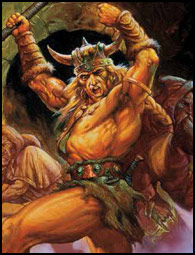 As seen on Tenkar’s Tavern this morning (seriously if you want up to date news on items in the OSR niche of the RPG world, you need to add Tenkar’s Tavern to your feed), the 2nd edition D&D reprints have popped up at Wizard’s site. The Player’s Handbook, Dungeon Master’s Guide, and Monstrous Manual are all there, going for $49.95 per book. Looks like the currently advertised release date is 5/21/2013.
As seen on Tenkar’s Tavern this morning (seriously if you want up to date news on items in the OSR niche of the RPG world, you need to add Tenkar’s Tavern to your feed), the 2nd edition D&D reprints have popped up at Wizard’s site. The Player’s Handbook, Dungeon Master’s Guide, and Monstrous Manual are all there, going for $49.95 per book. Looks like the currently advertised release date is 5/21/2013.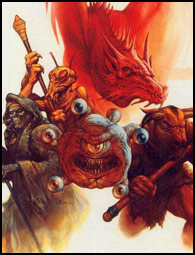 The 2nd edition reprints falls into the same area as the 3.5 ones did with me. I still have my 2e books and do not really feel the need to replace them with the reprints. I am sure that many have their roots in 2e though and will feel compelled to pick them up.
The 2nd edition reprints falls into the same area as the 3.5 ones did with me. I still have my 2e books and do not really feel the need to replace them with the reprints. I am sure that many have their roots in 2e though and will feel compelled to pick them up.
